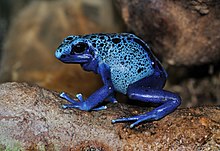
Back الضفدع السام الازرق ARZ Синя жаба дърволаз Bulgarian Granota fletxa blava Catalan Pralesnička azurová Czech Blauer Baumsteiger German Dendrobates azureus Esperanto Dendrobates azureus Spanish قورباغه زهرآگین آبی Persian Sininuolimyrkkysammakko Finnish Dendrobates azureus French
This article needs additional citations for verification. (August 2023) |
| Blue poison dart frog | |
|---|---|

| |
| Scientific classification | |
| Domain: | Eukaryota |
| Kingdom: | Animalia |
| Phylum: | Chordata |
| Class: | Amphibia |
| Order: | Anura |
| Family: | Dendrobatidae |
| Genus: | Dendrobates |
| Species: | |
| Subspecies: | D. t. "azureus"
|
| Trinomial name | |
| Dendrobates tinctorius "azureus" (Hoogmoed, 1969)
| |
The blue poison dart frog or blue poison arrow frog (Dendrobates tinctorius "azureus") is a poison dart frog found in the "forest islands" surrounded by the Sipaliwini Savanna in southern Suriname. Its indigenous Tiriyo name is okopipi. The name "azureus" comes from its azure blue color. While first described as a valid species and usually recognized as such in the past, recent authorities generally treat it as a morph of D. tinctorius, although a few treat it as a subspecies of D. tinctorius or continue to treat it as its own species.[1][2][3][4] To what extent it differs from the blue D. tinctorius in southern Guyana, adjacent Pará (Brazil) and possibly far southwestern Suriname, is also a matter of dispute, and many herpetologists, as well as many people keeping poison dart frogs in captivity, have not distinguished these, with all commonly being identified as "azureus".[3]
- ^ a b Philippe Gaucher; Ross MacCulloch (2010). "Dendrobates tinctorius". IUCN Red List of Threatened Species. 2010: e.T55204A11265402. doi:10.2305/IUCN.UK.2010-2.RLTS.T55204A11265402.en.
- ^ Wollenberg, Katharina C.; Veith, Michael; Noonan, Brice P.; Lötters, Stefan (2006). Quattro, J. M (ed.). "Polymorphism Versus Species Richness—systematics of Large Dendrobates from the Eastern Guiana Shield (Amphibia: Dendrobatidae)". Copeia. 6 (4): 623. doi:10.1643/0045-8511(2006)6[623:PVSROL]2.0.CO;2. S2CID 51861356.
- ^ a b d'Orgeix, C.A.; Hardy, D.; Witiak, S.M.; Robinson, L.R.; Jairam, R. (2019). "The Blue Dyeing Poison-Dart Frog, Dendrobates tinctorius (Dendrobates azureus, Hoogmoed 1969): extant in Suriname based on a rapid survey". Amphibian & Reptile Conservation. 13 (2): 259–264.
- ^ Hoogmoed, M.S. (2019). "Unpublished population data of Dendrobates azureus Hoogmoed 1969 obtained in 1968 and 1970, and its historical and current taxonomic status". Amphibian & Reptile Conservation. 13 (2): 95–101.